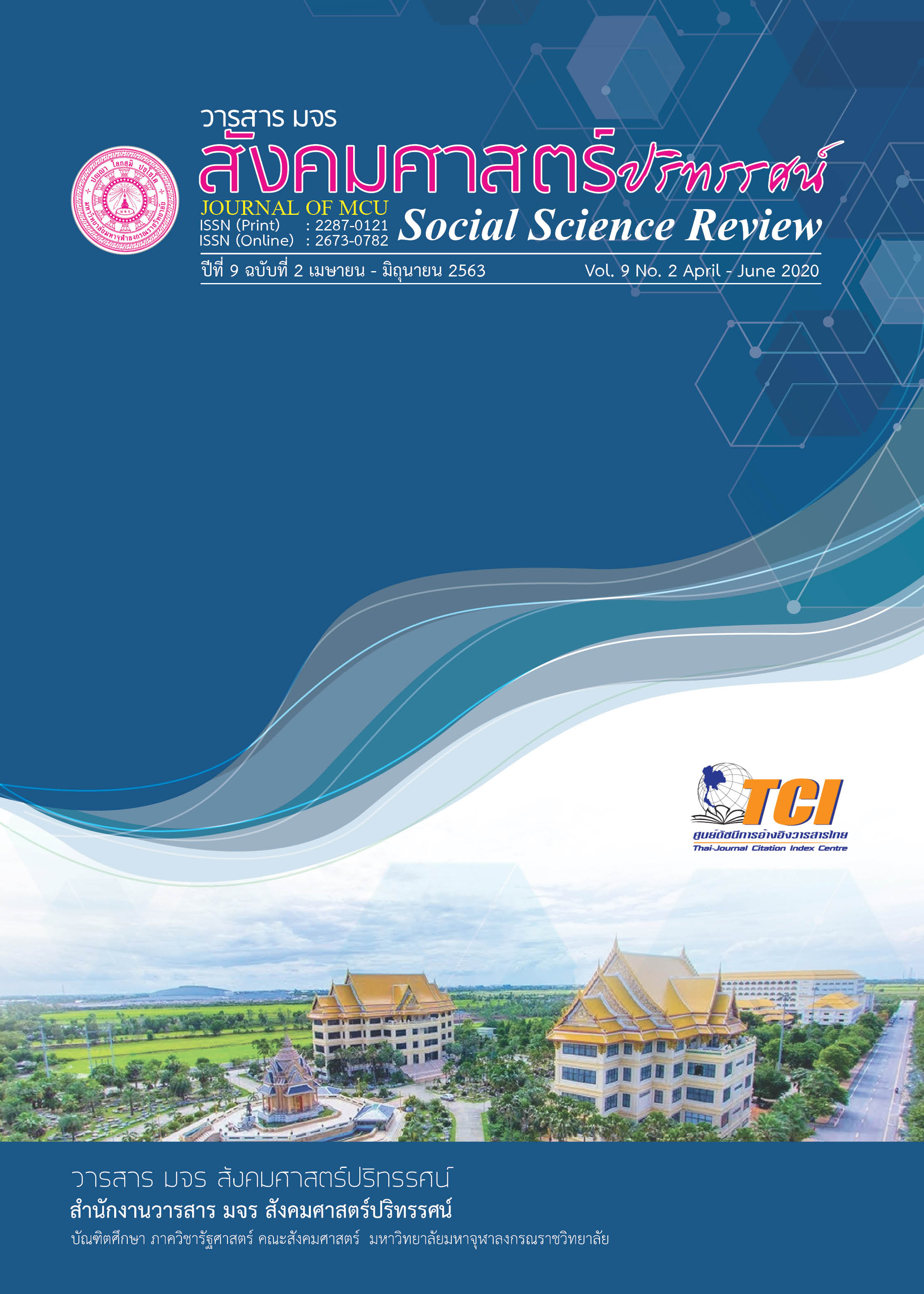องค์ประกอบขององค์การที่มีสมรรถนะสูงของมหาวิทยาลัยเอกชน: กรณีศึกษามหาวิทยาลัยคริสเตียน
คำสำคัญ:
องค์การที่มีสมรรถนะสูง, การให้บริการที่เป็นเลิศ, นวัตกรรมการจัดการบทคัดย่อ
การวิจัยครั้งนี้มีวัตถุประสงค์เพื่อตรวจสอบความสอดคล้องของโครงสร้างเชิงองค์ประกอบขององค์การที่มีสมรรถนะสูงของมหาวิทยาลัยเอกชนกับข้อมูลเชิงประจักษ์และศึกษาองค์ประกอบขององค์การที่มีสมรรถนะสูงของมหาวิทยาลัยเอกชน เก็บรวบรวมข้อมูลจากบุคลากรทุกระดับในสังกัดมหาวิทยาลัยคริสเตียน รวมทั้งสิ้นจำนวน 250 คน โดยกลุ่มเป้าหมายดังกล่าวมาจากการสุ่มแบบเฉพาะเจาะจง เครื่องมือที่ใช้ในการวิจัยครั้งนี้เป็นแบบสอบถามแบบมาตราส่วนประมาณค่า 5 ระดับ มีค่าความเชื่อมั่นเท่ากับ 0.97 สถิติที่ใช้ในการวิเคราะห์ข้อมูลประกอบด้วย ค่าความถี่ ค่าร้อยละ ค่าเฉลี่ย ส่วนเบี่ยงเบนมาตรฐาน และการวิเคราะห์องค์ประกอบเชิงยืนยัน ผลการวิจัยนี้ประกอบด้วย 2 ส่วน ได้แก่ ผลการวิเคราะห์องค์ประกอบเชิงยืนยันซึ่งพบว่าค่าวัดระดับความกลมกลืน คือ Chi-square (x2) = 431.207, df = 331, p-value = 0.000, x2/df(CMIN/DF) = 1.303, RMR =0.021, RMSEA = 0.036, GFI = 0.897, AGFI =0.856, TLI= 0.982 และ CFI = 0.987 แสดงว่าการวิเคราะห์องค์ประกอบขององค์การที่มีสมรรถนะสูงของมหาวิทยาลัยเอกชนเชิงยืนยันมีความสอดคล้องกับข้อมูลเชิงประจักษ์ ประกอบด้วย 3 ด้าน ได้แก่ 1) การนำอย่างมีกลยุทธ์ 2) การให้บริการที่เป็นเลิศและ 3) นวัตกรรมการจัดการ จากผลการวิจัยนี้ ผู้บริหารสถาบันอุดมศึกษาเอกชนจึงควรให้ความสำคัญอย่างยิ่งต่อการบริหารจัดการองค์การอย่างมีกลยุทธ์ การให้บริการกับผู้รับบริการและผู้มีส่วนได้ส่วนเสีย และการพัฒนากระบวนงานภายในและภายนอกสถาบัน
เอกสารอ้างอิง
ช่วงโชติ พันธุเวช. (2547). การจัดการคุณภาพ. กรุงเทพฯ: เพชรเกษมการพิมพ์.
ชิษณุพงศ์ ทองพวง. (2556). องค์ประกอบการบริหารคุณภาพทั่วทั้งองค์การของมหาวิทยาลัยเอกชนในประเทศไทย (ดุษฎีนิพนธ์ปริญญาปรัชญาดุษฎีบัณฑิต สาขาวิชาการจัดการภาครัฐและเอกชน). กรุงเทพฯ: มหาวิทยาลัยคริสเตียน.
บุศรินทร์ สุจริตจันทร์. (2553). รูปแบบองค์การที่มีศักยภาพการทำงานสูงของวิทยาลัยพยาบาล สังกัดกระทรวงสาธารณสุข. กรุงเทพฯ: มหาวิทยาลัยศิลปากร.
ศรีวรรณ เอี่ยมรุ่งโรจน์. (2552). นวัตกรรมเสาหลักองค์กร HPO เคล็ดสร้าง ปตท.ก้าวกระโดดกะเทาะแกน Innovation Management ของ PTT. สืบค้น 25 กรกฎาคม 2562, จาก http://www.boybdream.com/manager-news-content.php?newid=98248
สำนักงานคณะกรรมการการอุดมศึกษา. (2554). คู่มือการประกันคุณภาพการศึกษาภายในสถานศึกษาระดับอุดมศึกษา พ.ศ. 2553. กรุงเทพฯ : ห้างหุ้นส่วนจำกัด ภาพพิมพ์.
สำนักงานคณะกรรมการพัฒนาระบบราชการ. (2551). คู่มือคำอธิบายตัวชี้วัดการพัฒนาคุณภาพการบริหารจัดการภาครัฐปีงบประมาณ พ.ศ.2552 ระดับความสำเร็จของการพัฒนาคุณภาพการบริหารจัดการภาครัฐ ส่วนราชการระดับกรม. กรุงเทพฯ: บริษัท ซีโน พับลิซซิ่ง (ประเทศไทย) จำกัด.
อภินันต์ อันทวีสิน. (2562). องค์ประกอบขององค์การที่มีสมรรถนะสูงของมหาวิทยาลัยเอกชน: กรณีศึกษามหาวิทยาลัยคริสเตียน (ดุษฎีนิพนธ์ปริญญาปรัชญาดุษฎีบัณฑิต สาขาวิชาการจัดการภาครัฐและเอกชน). กรุงเทพฯ: มหาวิทยาลัยคริสเตียน.
Buytendijk, F. (2006). The Five Key to Building a High-Performance Organization (Gartner Group). Business Performance Management Magazine, 4(1), 24-47.
Carew, D. et al. (2006). Is Your Organization High-Performance Organization. Retrieved from http://www.pearsonhighered.com/ samplechapter /013144909.pdf
Miller, D. & Miller, B. (2005). Managing for the long Run Lesson for the Competitive Advantage from Great Family Business. Boston: Harvard Business Review.
Shermerhorn, H. & Oborn. (2000). Organization Behavior (7th ed.). New York: John Wiley & Sons, Inc.
ดาวน์โหลด
เผยแพร่แล้ว
รูปแบบการอ้างอิง
ฉบับ
ประเภทบทความ
สัญญาอนุญาต
ลิขสิทธิ์ (c) 2020 วารสาร มจร สังคมศาสตร์ปริทรรศน์

อนุญาตภายใต้เงื่อนไข Creative Commons Attribution-NonCommercial-NoDerivatives 4.0 International License.
เพื่อให้เป็นไปตามกฎหมายลิขสิทธิ์ ผู้นิพนธ์ทุกท่านต้องลงลายมือชื่อในแบบฟอร์มใบมอบลิขสิทธิ์บทความให้แก่วารสารฯ พร้อมกับบทความต้นฉบับที่ได้แก้ไขครั้งสุดท้าย นอกจากนี้ ผู้นิพนธ์ทุกท่านต้องยืนยันว่าบทความต้นฉบับที่ส่งมาตีพิมพ์นั้น ได้ส่งมาตีพิมพ์เฉพาะในวารสาร มจร สังคมศาสตร์ปริทรรศน์ เพียงแห่งเดียวเท่านั้น หากมีการใช้ภาพหรือตารางหรือเนื้อหาอื่นๆ ของผู้นิพนธ์อื่นที่ปรากฏในสิ่งตีพิมพ์อื่นมาแล้ว ผู้นิพนธ์ต้องขออนุญาตเจ้าของลิขสิทธิ์ก่อน พร้อมทั้งแสดงหนังสือที่ได้รับการยินยอมต่อบรรณาธิการ ก่อนที่บทความจะได้รับการตีพิมพ์ หากไม่เป็นไปตามข้อกำหนดเบื้องต้น ทางวารสารจะถอดบทความของท่านออกโดยไม่มีข้อยกเว้นใดๆ ทั้งสิ้น





